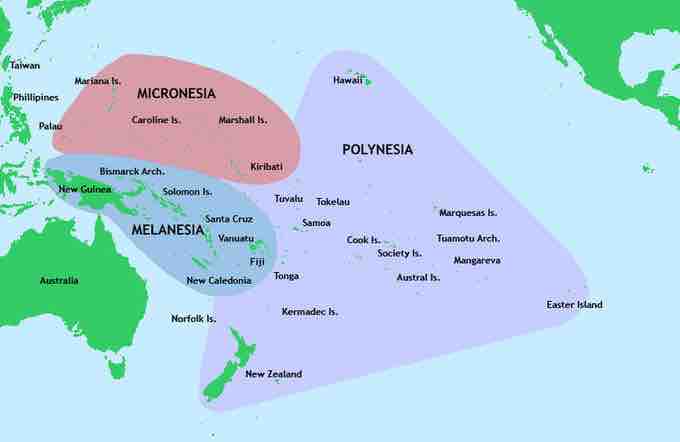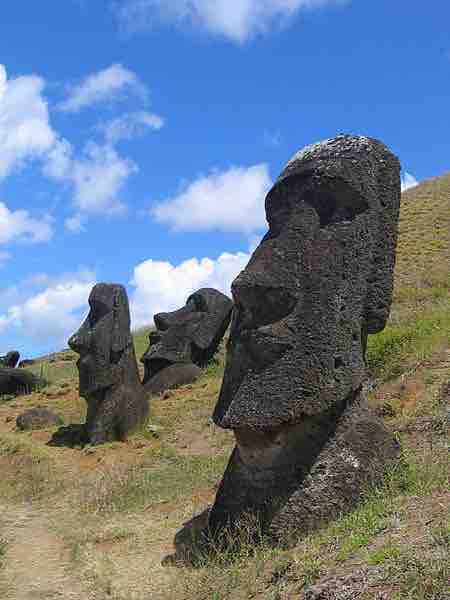Introduction: Oceania
Art of Oceania properly encompasses the artistic traditions of the people indigenous to Australia, New Zealand, and the Pacific Islands. The area is often broken down into four separate regions: Polynesia, Micronesia, Australia, and Melanesia. The ancestors of the people of these islands came from Southeast Asia by two different groups at separate times. The first, an Australoid people and the ancestors of modern day Melanesians and Australian Aboriginals, came to New Guinea and Australia, with the Melanesians expanding as far as the northern Solomon Islands by 38,000 BCE. The second wave of peoples came from Southeast Asia 30,000 years later, where they reached further remote Pacific islands. These early peoples lacked a writing system and made works on perishable materials, so few records of them exist from this time.

Major culture areas of Oceania: Micronesia, Melanesia, Polynesia, and Australia
The four cultural areas of Oceania are illustrated on this map, including the land masses of Australia, New Guinea, and New Zealand and the numerous Pacific Islands.
By 1500 BCE, descendants of the second wave of settlers began to expand and spread into the more remote islands. At around the same time, art began to appear in New Guinea, including the earliest examples of sculpture in Oceania. From around 1000 BCE on, the Lapita people consolidated and began to create the contemporary Polynesian cultures of Samoa, Tonga, and Fiji. From there they ventured further out into the Pacific and settled the Marquesas and northern Cook Islands.
The Lapita
The Lapita were an early culture with an influential artistic tradition. Dating from about 1500 BCE to 500 BCE, they are thought to be the ancestors of the modern day cultures of Polynesia, Micronesia, and some parts of Melanesia. The culture was formed by the second wave of Oceanic settlers, and the name comes from the site of Lapita in New Caledonia, which was among the first places its distinctive sculpture would be found. Their art is best known by their ceramics, which include elaborate geometric motifs and sometimes anthropomorphic imagery. It is thought some of the designs may be related to modern Polynesian tattoos and barkcloths. The ceramics were created by firing a comblike tool that stamped the designs on to wet clay; each stamp would have one design and would be layered until an elaborate pattern was created. Their usage is believed to have been primarily practical, used in cooking, serving, and storing food.
Interaction with Mainland Asia
The period from 1000 BCE to 1000 CE is characterized by increasing trade and interaction between the Pacific Islands and mainland Asia. Starting around 600 BCE, works of the Dongson culture of Vietnam—known for their bronze working—can be found in Oceania, and their imagery has a strong influence on the indigenous artistic tradition. New areas were also settled during this time, including Hawaii, Easter Island, Tahiti, and New Zealand. Starting around 1100 CE, the people of Easter Island began construction of nearly 900 moai (large stone statues). At about 1200 CE, the people of Pohnpei, an island in Micronesia, embarked on another megalithic construction, building Nan Madol, a city of artificial islands and a system of canals. By 1500, the first European explorers reached Oceania. Although previous artistic and architectural traditions continued, the various regions began to diverge and record more distinct cultures.

Moai at Rano Raraku, Easter Island
Starting around 1100 CE, the people of Easter Island began construction of nearly 900 moai, or large stone statues.